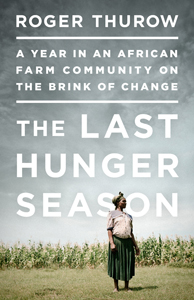BY ROGER THUROW
REVIEWED BY TERRI SCHLICHENMEYER
 Your eyes are bigger than your stomach because for lunch you ordered a sandwich, salad, a side dish and drink at the local deli. About halfway through the meal, you feel stuffed- you wad up the meal, slurp the rest of your drink, and throw the rest away. Excessive food waste – not many think about it while they are tossing extra food in the trash or “super-sizing” their meal – but this novel might make you think twice – The Last Hunger Season by Roger Thurow.
Your eyes are bigger than your stomach because for lunch you ordered a sandwich, salad, a side dish and drink at the local deli. About halfway through the meal, you feel stuffed- you wad up the meal, slurp the rest of your drink, and throw the rest away. Excessive food waste – not many think about it while they are tossing extra food in the trash or “super-sizing” their meal – but this novel might make you think twice – The Last Hunger Season by Roger Thurow.
Andrew Youn is a man with seemingly unlimited energy. Journalist Roger Thurow met Youn described as a “skinny, bespectacled… geek from Minnesota” during a snowstorm in Chicago, where Youn told Thurow about the farmers he’d met in Kenya in the early 2000s. Youn explained that Kenya’s use of ancient farming traditions led to wanjala (hunger time) and starvation because of a lack of access to modern methods of planting.
Youn, an MBA student, had been pondering this, and he had an idea─and One Acre, a nonprofit program that helps sub-Saharan farmers reap higher yields from their shambas through education, seeds, and fertilizer, was born.
 Thurow, who’d also seen poverty and starvation in Africa, was intrigued. He asked Youn if he might follow four farmers for a year, through wanjala and beyond.
Thurow, who’d also seen poverty and starvation in Africa, was intrigued. He asked Youn if he might follow four farmers for a year, through wanjala and beyond.
As a village elder and farmer Leonida Wanyama needed to set a good example for others, which is why she joined One Acre. She was amazed the first year at the bounty she reaped, but it wasn’t enough. Her husband, Peter, was ill and their son, Gabriel was away at school. School was very expensive: $255 a year.
Rasoa Wasike was so pleased with One Acre that she inspired several others to join. But that wasn’t Rasoa’s only endeavor; she was lucky to find other employment so her wanjala wasn’t quite so severe.
Zipporah Bikiti had jeered at neighbors who used the One Acre methods, until she saw their lush, bountiful maize fields. She was determined that this wanjala – a particularly long, terrible one – would be her family’s last.
Francis Mamati and his wife had a vision. They had three acres and their son, who owned a nearby café, had a small plot, too. A shamba like that, properly farmed, could make dreams come true.
So you might wonder why you should read a book about a bunch of miniature farms half a world away? The Last Hunger Season is about those four Kenyan farmers-and the last time each had little more than tea to feed their families from January through June. While sharing their stories, the politics behind fixing what’s wrong, and the triumph of success, author Roger Thurow also gives his readers a huge lesson in gratitude─and chances are, you have food and don’t really worry about it, but this book never lets you forget that.
I think you’re going to like The Last Hunger Season, just don’t be surprised if it makes you a little uncomfortable. Still, if you want something that’s sobering, glorious, and thought-provoking, this book is “super-sized.”





